With the rapid evolution of technology, businesses have to adapt quickly to stay ahead of the competition. One of the critical aspects of business transformation is software development, and the choice of development methodology is a crucial decision that businesses have to make.
In recent years, No Code and Low Code platforms have gained immense popularity among businesses looking to develop software quickly and efficiently, without the need for extensive coding knowledge. However, some argue that High Code development still holds an edge over its low-code counterparts in terms of flexibility and scalability.
So, which development methodology should you choose for your business? In this blog, we'll compare and contrast No Code, Low Code, and High Code development and explore their benefits and drawbacks. By the end of this discussion, you'll have a better understanding of which software development methodology will best suit your business's unique needs.
Let's dive in!

Gone are the days when companies depended on developer resources who built software or applications from scratch to a working prototype. Modern development practices are constantly looking to fasten delivery and up the output standards to meet several factors that can convince all customers.
Recent digital transformation trends are rapidly changing a business’s approach to completing a project. In fact, the pandemic has brought a considerable amount of revolution to how software development happens.
Companies are a bit confused about choosing among low code,
no code and high code development solutions as all three approaches come with their own qualities. However, low code/no code is adopted more due to the recent market demands.
The customer requirements, expectations, budget, and time constraints are determining which method is apt for a project. Companies and their development teams are looking to choose the perfect approach so that a project is profitable for both customers and themselves.
Before we get into the comparisons and similarities among no code, low code, and high code, let’s find out how all the development models work.
No Code Development Explained
No code assembly model is an approach that does not require us to write even a single line of coding. But this does not mean that there is no code involved at all. It is just that the code is ready-made and hidden from developers who have zero coding skills.
This method uses a visual development interface and requires business users to drag and drop software components and use tools according to the application’s needs.
Citizen developers and professionals with no programming knowledge find this method very easy as they just have to assemble pre-built blocks to create a whole application. Companies that lack programmers with technical skills should choose this method.
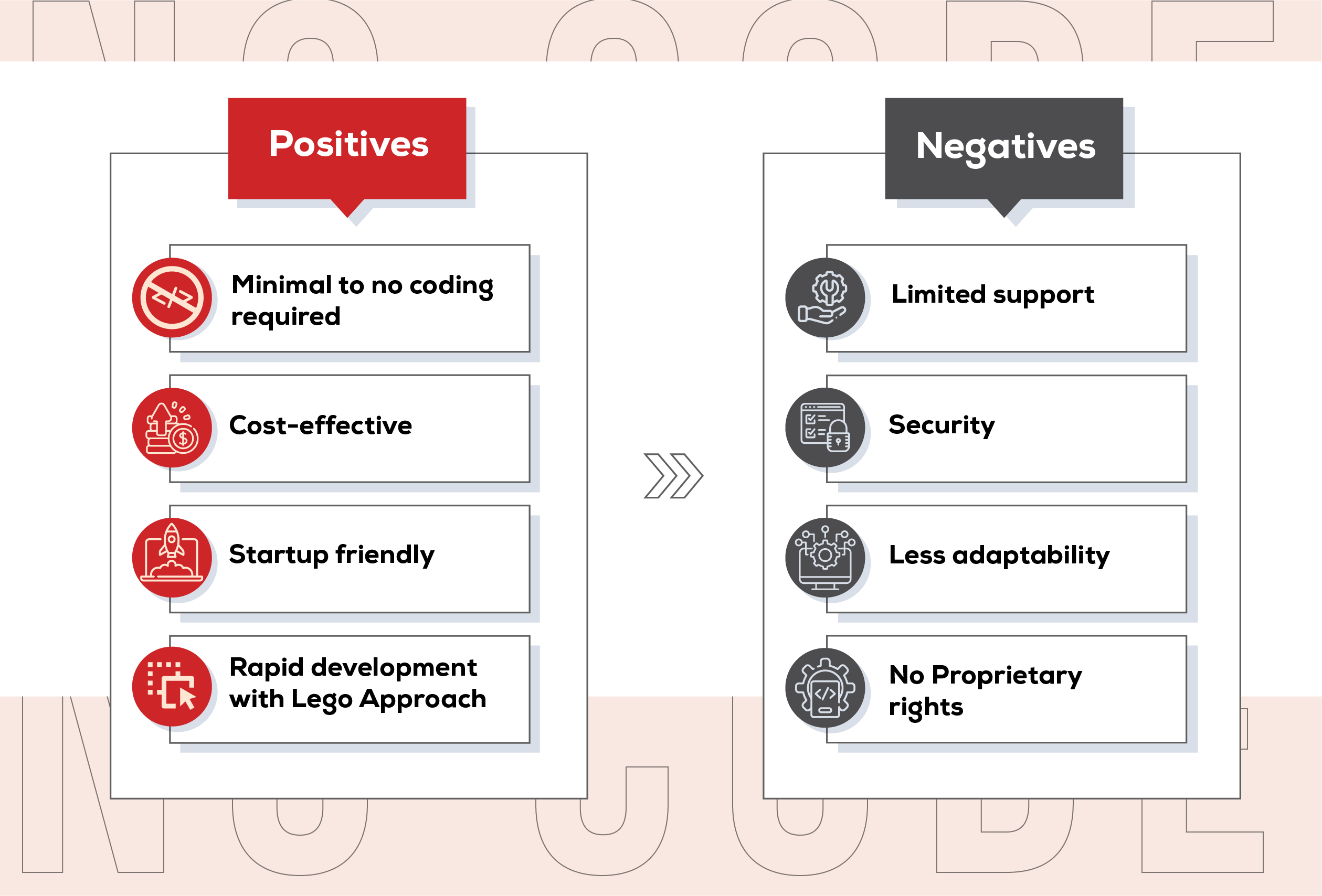
Positives of using No Code
-
Minimal to no coding required: Development is made possible with less technical skills.
-
Cost-effective: Does not require much development costs when compared to hiring skilled developers.
-
Startup friendly: Minimal IT resource requirement makes low code method appealing for startups.
-
Rapid development with Lego Approach: Apps are built quickly with drag-and-drop components and tools.
Negatives of using No Code
-
Limited support: Low-level features such as audio and video processing might not get proper support.
-
Security: No code development leads to data security and compliance issues. Hence fintech, health tech, and similar startups don’t use this method.
-
Less adaptability: By following a no code method you will not be able to easily adapt system integration.
-
No proprietary rights: Source code ownership is impossible and hence problems will arise in the longer run.
Low Code Development Explained
Low code development platforms effectively help in building applications with little to no coding requirements. The majority of the processes are automated and apps are created with flexibility. Apps can be delivered quickly by using the graphic user interface that contains drag-and-drop features similar to no code development.

Customization options are better when compared to no code development and this makes low code an impressive option. Selective features and services inside applications can be easily customized by experienced developers and this is something not possible in no code development.
Both marketers and developers are important when using low code development. This collaboration helps in creating more user-friendly products for a better customer experience.
Simply, junior developers and business users create components with the help of pre-built templates and marketers reduce the product-to-market time in the low code development process.
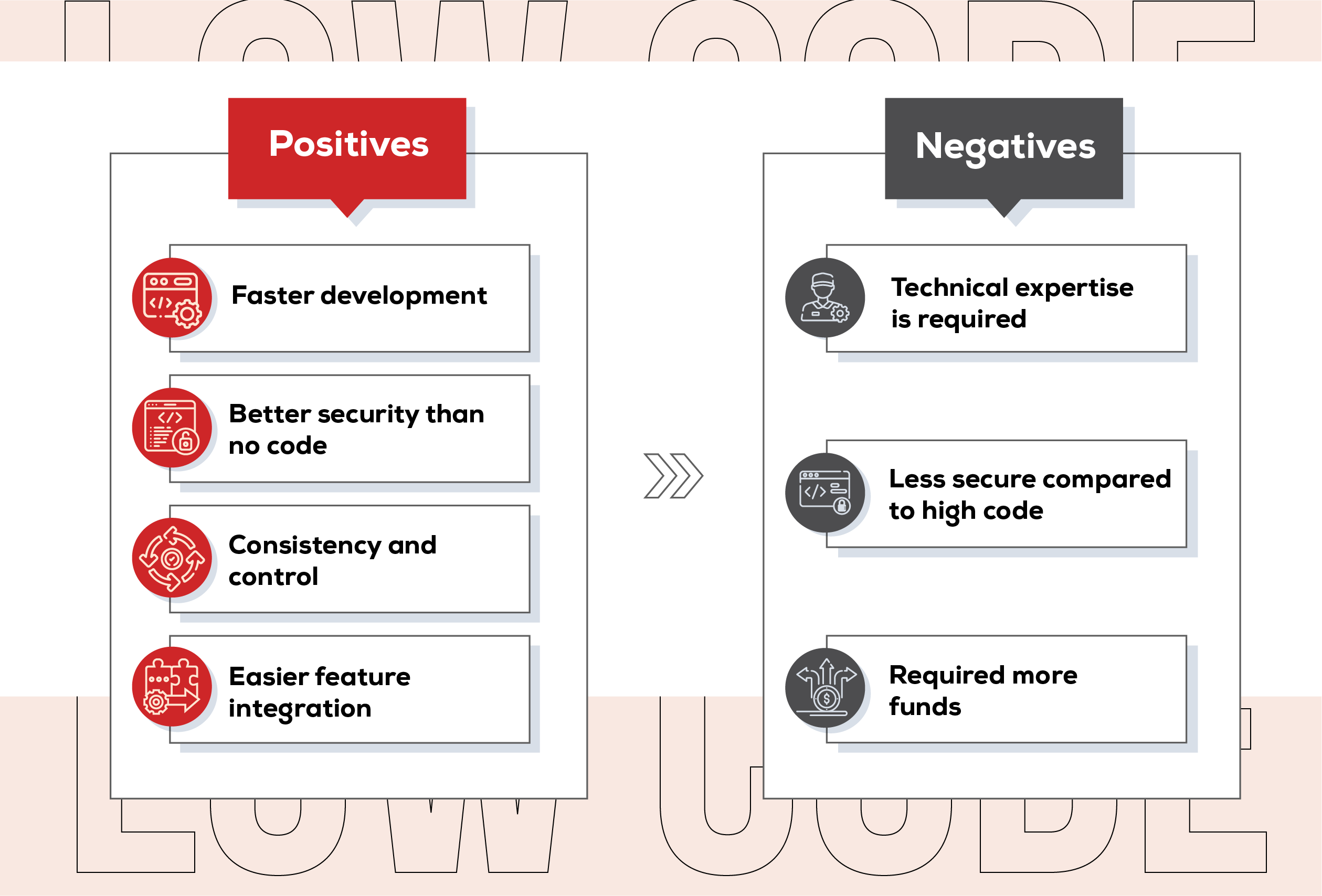
Positives of using Low Code
-
Faster development: Low code approach uses visual development tools to speed the development process and reduces time to market.
-
Better security than no code: Improved security using authentication (pre-built) and other useful modules like access management module.
-
Consistency and control: Low code development has better consistency and control over the content and can govern the front-end frameworks.
-
Easier feature integration: This development model can bend to changing market needs and customer requirements. However, there are limitations to customization.
Negatives of using Low Code
-
Technical expertise is required: Low code development needs a professional with technical knowledge while no code development does not need this.
-
Less secure compared to high code: Though low code is more secure than no code development, there are a few security limitations when compared to conventional development.
-
Required more funds: Low code development can be costlier when used for the longer run.
High Code Development Explained
High code development is the traditional way of building applications where developers write every line of the source code. A large team of developers is hired to create each aspect of an application and this style of development demands more time.
Though there is a lot of reliance on developers, flexible customization is a great bonus we get when practicing high code development. Unlike the other two approaches, there are no restrictions for the owner developing the application. This means any modules can be used to build a tailored end product.
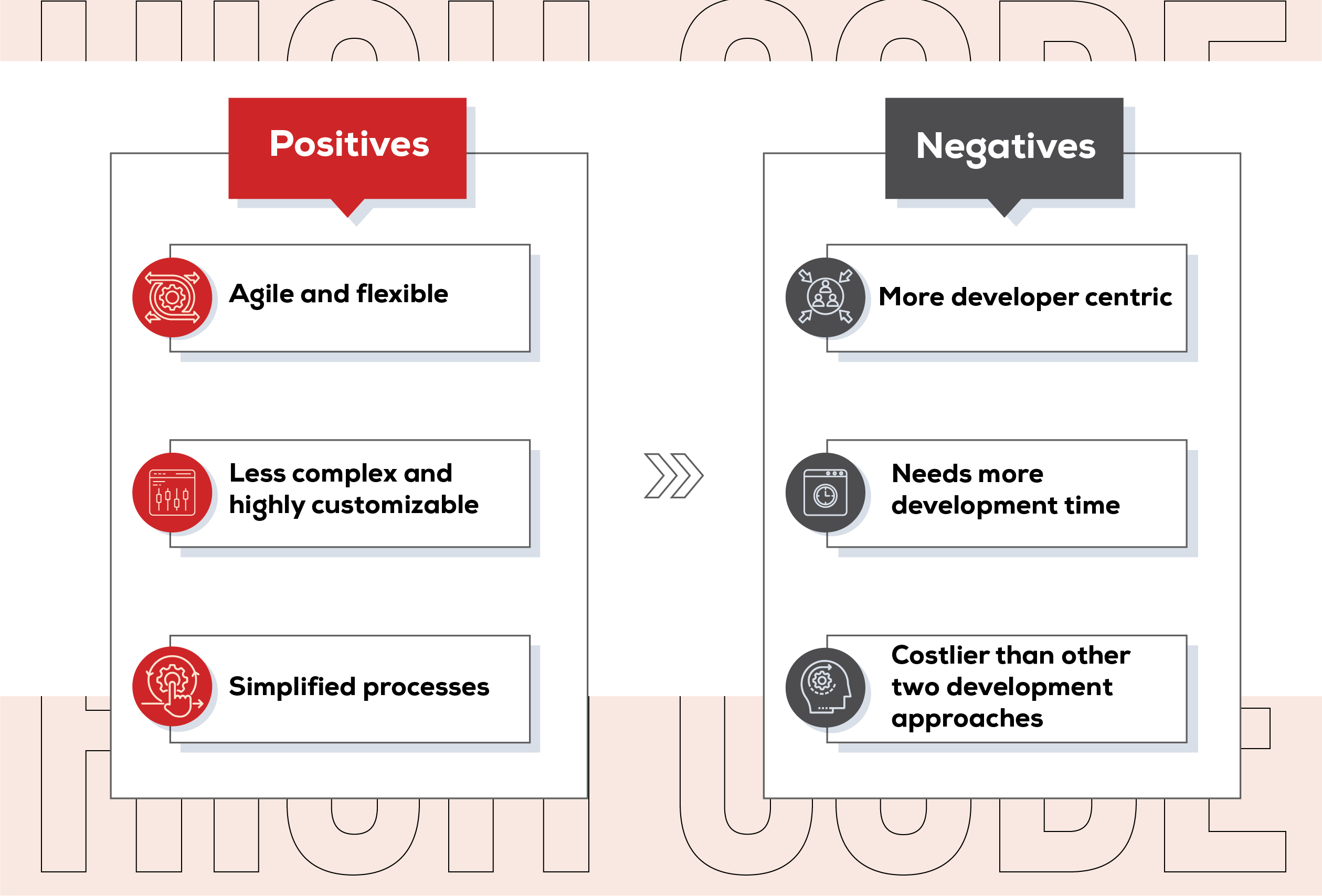
Positives of using High Code
-
Agile and flexible: High code development is the best method for developing application with utmost agility and flexibility.
-
Less complex and highly customizable: Customer requirements are met without complexity and newer features can be easily added.
-
High control: Complete control over every aspect of a project gives confidence to developers for dealing with future issues.
-
Simplified processes: Streamlined procedures and simpler processes give the advantage of easier management in development and delivery.
Negatives of using High Code
-
More developer-centric: High code development is more dependent on programmers with full control over the project.
-
Needs more development time: Each and every line of code is handwritten and this consumes more time compared to the other approaches.
-
Costlier than the other two development approaches: Hiring expert developers will cost higher than using pre-built tools.
Similarities between Low Code and No Code
The main reason to build low code and no code platforms was to reduce manual coding. Hence both approaches share a few beneficial similarities which you should know.
-
Democratizes technology development by allowing everyone to create their version of an application.
-
Both approaches give more design options which help in narrowing down to the best output.
-
The development phase is much faster compared to the high code approach and this impacts in a faster time to market.
-
More economical compared to the traditional way of developing where enterprises spend more on hiring programmers.
-
Enhanced collaboration among development teams and other non-technical experts.
-
Both approaches use virtual interfaces with drag and drop design templates.
How Low-code differs from No-Code Approach?
Having discussed the similarities, let’s take a look at the key differences between low code and no code.
Why you must select High Code development over Low Code/No Code Development?
Though low code/no code development has become familiar among several tech companies in recent times, developers still have second thoughts about using them. When a conventional way of development is followed, complex functions are easily implemented with the flexibility of customization.
Security plays a major role while taking up bigger projects and companies cannot compromise on data exploitations. Hence, high code development is recommended for building applications that contain sensitive data.
Though low code development can produce a commendable application at first, there can be problems in the future in form of bugs and more.
It is always better to follow high code development while working on large-scale projects as it enables integration of CI/CD and other methodologies like DevOps. There are several other advantages to using high code including space for creativity, freedom, and control over the development environment.
The Low Code Development Trend: Boon or Bane?
The core reason to choose low code development is to tackle the time to market problems with faster development. Companies are able to deliver applications on time with the current requirements of the market and customers. But will this be enough to satisfy users who will come again in the future with advanced requirements?
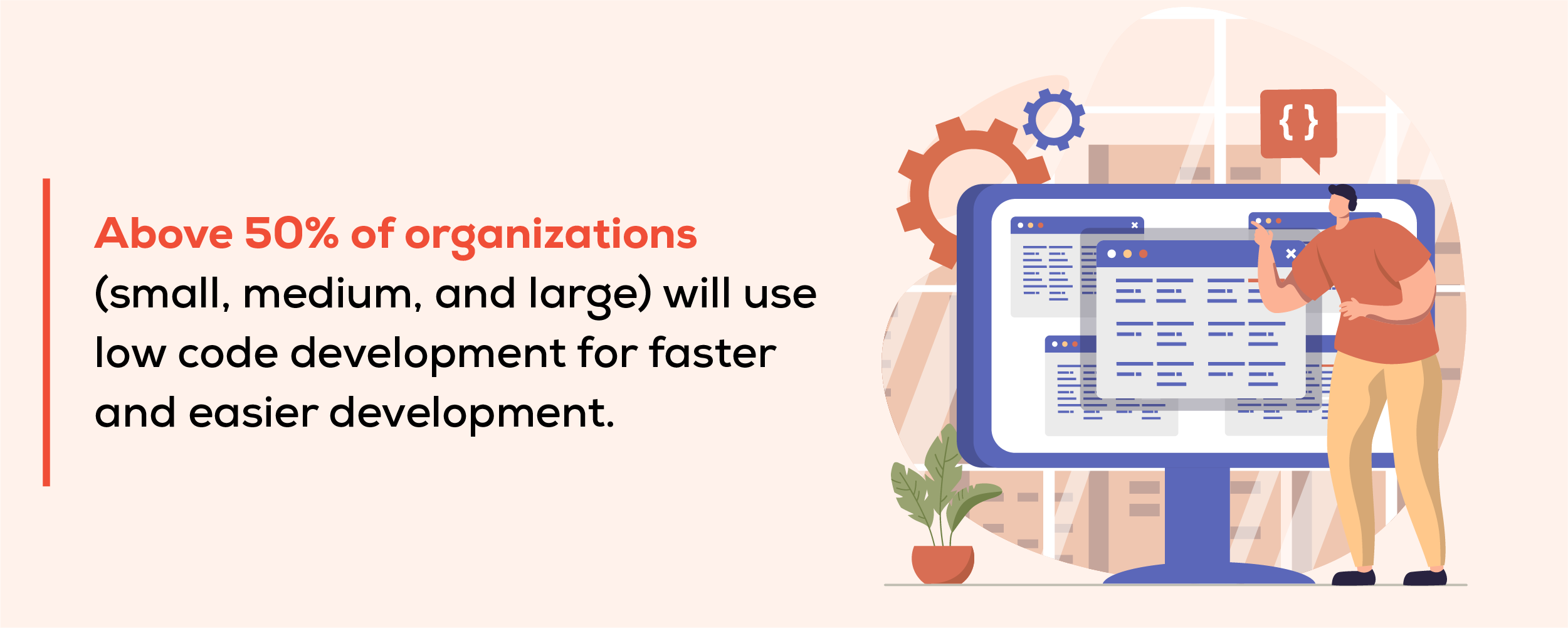
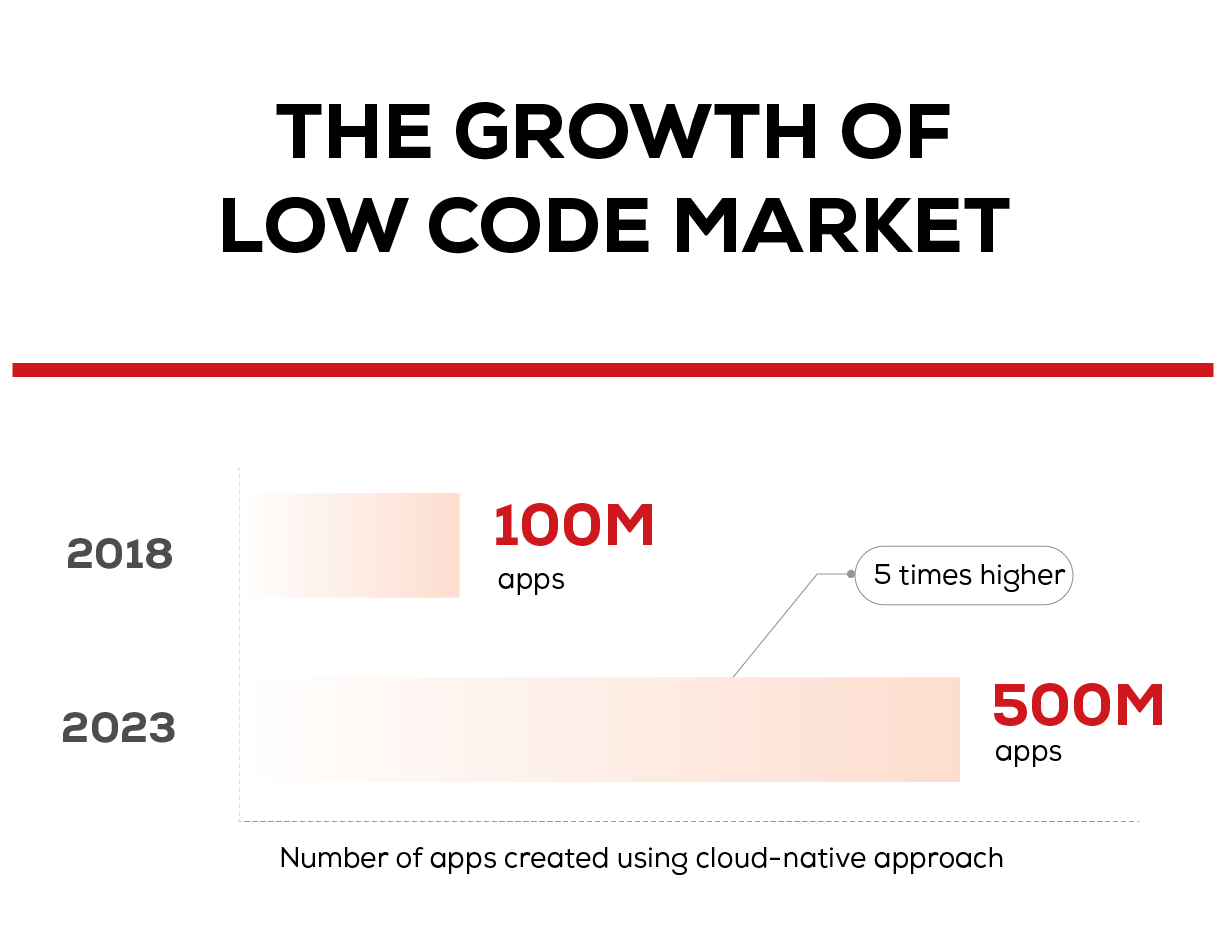
Source: https://kissflow.com/low-code/low-code-stats/
Though the above given numbers look encouraging for several reasons, there are experts who differ with this trend. Every development team accepts significant disadvantages while using low code and we have seen them in the earlier part of this blog. Choosing a development style totally depends on the needs of customers and market.
No Code vs. Low Code vs. High Code: Which approach will suit your project/organization?
Startup companies with minimal budgets and fewer programming resources can still opt low code or custom high code development for safer project management. Choosing this approach can let you create more reliable applications with security, ownership, and no limitations. This will help your company build trust among customers taking you to new heights in the future.
Said that, if you have undertaken a project of larger scale with a bigger budget, it is always safer to choose high code development. Though the approach costs more and takes more time, you will have the freedom to choose API services, hosts, and technologies.
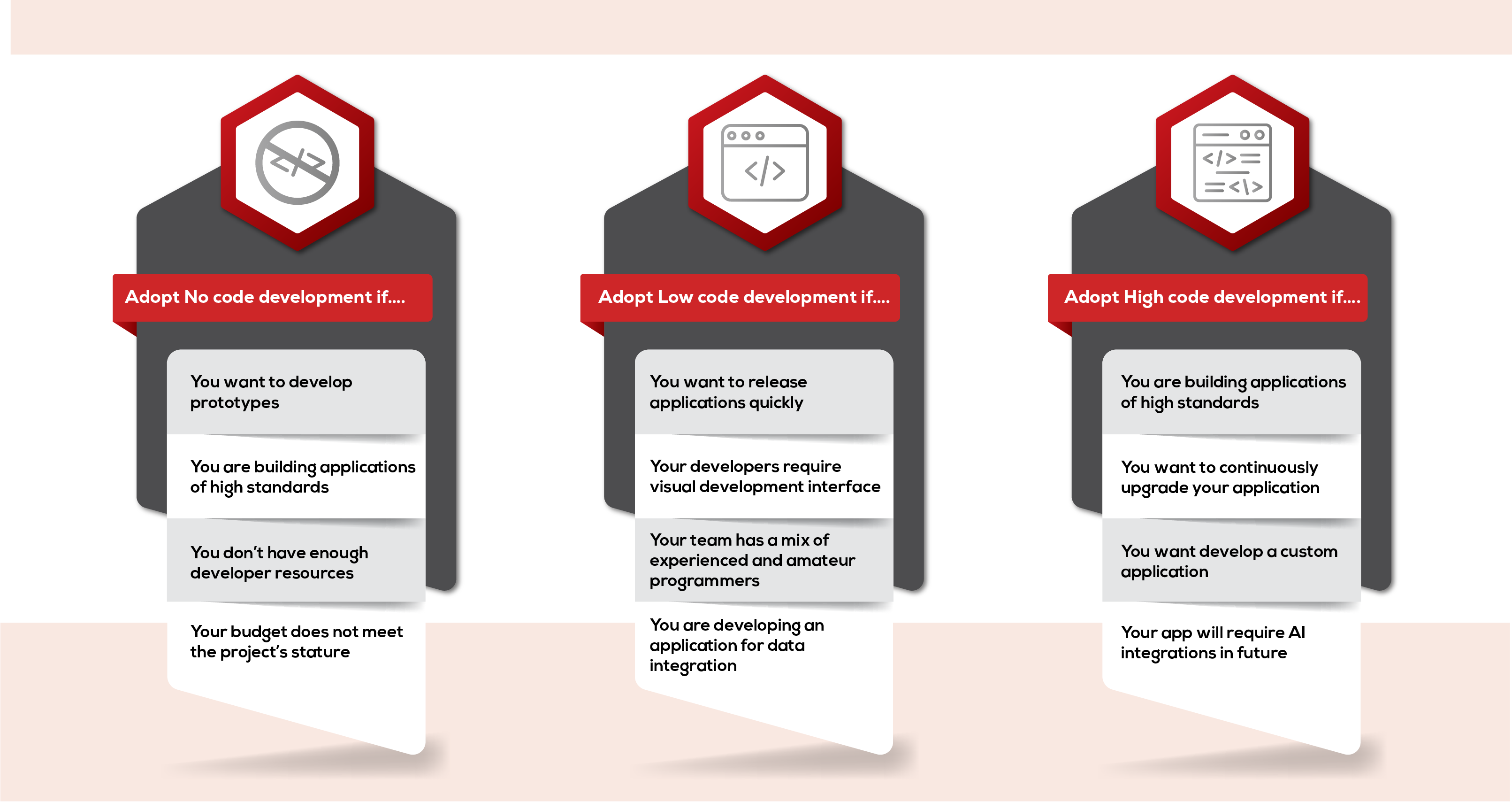
Wrap up
In conclusion, we can clearly see that each of the development approaches will be required by different companies of different sizes with varying needs. It all comes to addressing factors like cost, time, velocity, and agility. Technology will never stop giving us shortcuts and easy options. But businesses should make sensible decisions while picking a particular development model, as it determines the success and profits from a project.







